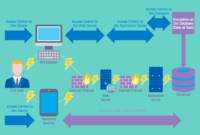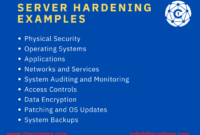Dedicated server security: essential steps and tools are paramount in today’s digital landscape, where cyber threats are constantly evolving. While dedicated servers offer greater control and resources compared to shared hosting, they also present unique security challenges. This guide explores the essential steps and tools needed to fortify your dedicated server, ensuring the safety and integrity of your data and applications.
From implementing strong passwords and access control to deploying firewalls and intrusion detection systems, this comprehensive guide will empower you to create a robust security posture for your dedicated server. We will delve into securing the operating system, network infrastructure, and data itself, leaving no stone unturned in our pursuit of a secure and resilient server environment.
Understanding Dedicated Server Security
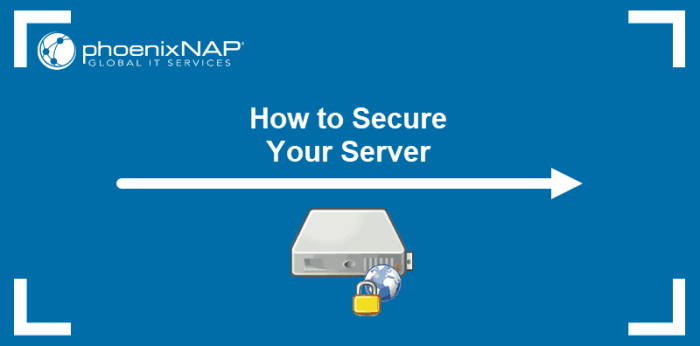
Dedicated servers offer unparalleled control and resources compared to shared hosting, but they also present a unique set of security challenges. Unlike shared hosting, where a single server hosts multiple websites, dedicated servers are solely dedicated to a single website or application.
This means that any security breach on a dedicated server can directly impact the entire website or application, making proactive security measures crucial.
Security Challenges of Dedicated Servers
Dedicated servers offer greater control and resources, but they also present unique security challenges. These challenges stem from the fact that a dedicated server is solely responsible for a single website or application, unlike shared hosting, where multiple websites share the same server.
Therefore, any security breach on a dedicated server can directly impact the entire website or application, emphasizing the importance of proactive security measures.
- Single Point of Failure:A dedicated server is a single point of failure. If the server is compromised, the entire website or application is vulnerable. This makes it crucial to implement robust security measures to prevent attacks and minimize the impact of any successful breach.
- Increased Attack Surface:Dedicated servers have a larger attack surface compared to shared hosting. This means that attackers have more potential entry points to exploit vulnerabilities. The server’s operating system, applications, and network configurations all represent potential targets for malicious actors.
- Greater Responsibility:With a dedicated server, the responsibility for security falls entirely on the user. This means that users need to be proactive in implementing security measures and staying up-to-date with the latest security threats.
Proactive Security Approach
Proactive security measures are essential for safeguarding dedicated servers from attacks. This approach involves implementing security practices and tools before any attack occurs.
- Regular Security Audits:Regular security audits help identify and address vulnerabilities before they can be exploited. These audits should cover all aspects of the server’s infrastructure, including the operating system, applications, and network configurations.
- Strong Passwords and Two-Factor Authentication:Using strong passwords and enabling two-factor authentication for all administrative accounts helps prevent unauthorized access to the server. Strong passwords should be at least 12 characters long and include a mix of uppercase and lowercase letters, numbers, and symbols.
- Regular Software Updates:Keeping all software, including the operating system, applications, and security tools, up-to-date is crucial for patching vulnerabilities and mitigating risks. Software updates often include security patches that address known vulnerabilities.
- Firewall Configuration:Configuring a firewall to block unauthorized access to the server is essential. Firewalls act as a barrier between the server and the outside world, preventing unauthorized connections.
- Intrusion Detection and Prevention Systems (IDPS):IDPSs monitor network traffic for suspicious activity and can block or alert about potential attacks. They help detect and prevent intrusions by analyzing network traffic and identifying patterns that indicate malicious activity.
Potential Security Threats
Dedicated servers are susceptible to various security threats, including:
- Malware:Malware can infect the server through various means, including email attachments, malicious websites, and vulnerabilities in software. Once installed, malware can steal data, compromise the server’s security, or launch further attacks.
- Denial-of-Service (DoS) Attacks:DoS attacks aim to overwhelm the server with traffic, making it unavailable to legitimate users. These attacks can be launched by sending a large number of requests to the server, causing it to crash or slow down significantly.
- Brute-Force Attacks:Brute-force attacks involve trying to guess passwords by repeatedly entering different combinations. These attacks can be automated using specialized tools, making them a significant threat to dedicated servers.
- SQL Injection:SQL injection attacks exploit vulnerabilities in web applications to gain unauthorized access to the server’s database. Attackers can use SQL injection to steal data, modify data, or even execute commands on the server.
- Zero-Day Exploits:Zero-day exploits target vulnerabilities that are unknown to the vendor and have not yet been patched. These exploits can be highly dangerous as they can be used to gain access to the server before security patches are available.
Essential Security Steps
Securing a dedicated server requires a multi-faceted approach. Implementing robust security measures is crucial to protect your data, applications, and overall server infrastructure from potential threats. This section will delve into essential security steps that can significantly enhance the security posture of your dedicated server.
Security Measures and Their Implementation
| Security Measure | Description | Implementation | Benefits |
|---|---|---|---|
| Strong Passwords | Employing strong passwords is fundamental to prevent unauthorized access to your server. Strong passwords are complex and difficult to guess, typically using a combination of uppercase and lowercase letters, numbers, and special characters. | Use a password manager to generate and store strong passwords. Regularly change passwords for all accounts, including administrative accounts. | Reduces the risk of unauthorized access and password compromise. |
| Access Control | Access control restricts access to your server based on user roles and permissions. This ensures that only authorized individuals can access specific resources and perform certain actions. | Implement a robust access control system, such as role-based access control (RBAC), which assigns roles and permissions to users. Regularly review and update access permissions. | Prevents unauthorized access and actions, limiting the potential impact of security breaches. |
| Regular Updates | Software updates often include security patches that address vulnerabilities. Regularly updating your operating system, applications, and server software is crucial to mitigate known security risks. | Enable automatic updates for your operating system and applications. Regularly check for and install updates manually. | Reduces the risk of exploitation of known vulnerabilities, strengthening the server’s security posture. |
| Firewalls | Firewalls act as a barrier between your server and the external network, blocking unauthorized access attempts. They analyze incoming and outgoing network traffic, allowing only authorized connections. | Implement a firewall on your server, either hardware-based or software-based. Configure the firewall to block unwanted traffic and allow only necessary connections. | Prevents unauthorized access to your server, blocking malicious traffic and potential attacks. |
| Intrusion Detection Systems (IDS) | Intrusion detection systems monitor network traffic for suspicious activities, detecting potential attacks and alerting administrators. | Install and configure an IDS on your server. Monitor the IDS alerts and investigate suspicious activities. | Detects potential attacks and provides early warning of malicious activity, allowing for timely response and mitigation. |
| Security Audits | Regular security audits assess the security posture of your server, identifying potential vulnerabilities and weaknesses. | Conduct regular security audits, either internally or by hiring a third-party security firm. Address any vulnerabilities identified during the audit. | Identifies security gaps and vulnerabilities, enabling timely remediation and strengthening overall security. |
Securing the Operating System
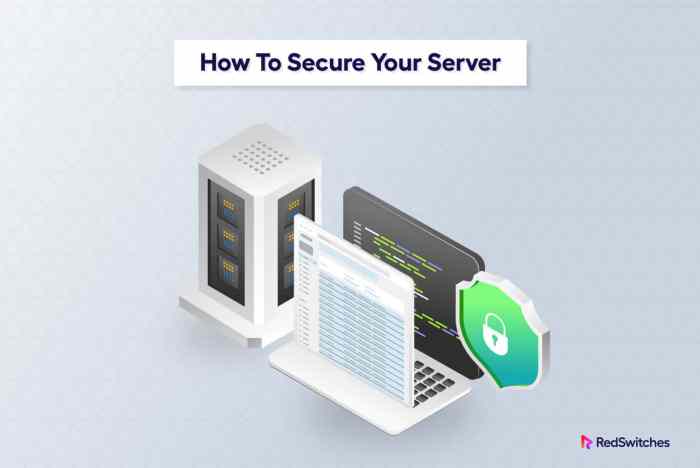
The operating system (OS) serves as the foundation for your dedicated server, managing its resources and providing a platform for applications. Choosing a secure OS and implementing appropriate hardening measures are critical for protecting your server from various threats.
Choosing a Secure Operating System
Selecting a secure OS for your dedicated server is the first step towards a robust security posture. Consider the following factors when making your choice:
- Security Track Record:Research the OS’s history of security vulnerabilities and patches. Look for a platform known for its proactive approach to security updates and timely vulnerability mitigation.
- Security Features:Evaluate the built-in security features of the OS, such as firewalls, intrusion detection systems (IDS), and user account management.
- Community Support:An active community of developers and security researchers can provide valuable support and contribute to the OS’s security by identifying and addressing vulnerabilities.
Hardening the Operating System
Once you’ve chosen a secure OS, it’s essential to harden it further by implementing security configurations and updates. This involves taking steps to minimize attack surfaces and strengthen the OS’s defenses.
- Disable Unnecessary Services:Identify and disable services that are not required for your server’s functionality. This reduces the number of potential attack vectors.
- Implement Strong Passwords and Authentication:Use strong passwords for all administrative accounts and enable multi-factor authentication (MFA) whenever possible.
- Regularly Update the OS:Install security updates and patches promptly to address vulnerabilities and keep your OS up to date.
- Configure Firewall Rules:Set up a firewall to restrict incoming and outgoing network traffic, allowing only essential connections.
Securing the Operating System with Tools and Techniques
Various tools and techniques can help you secure your dedicated server’s operating system:
- Security Information and Event Management (SIEM):SIEM tools collect and analyze security events from various sources, enabling you to detect and respond to threats.
- Intrusion Detection Systems (IDS):IDS tools monitor network traffic for suspicious activity and alert administrators to potential attacks.
- Vulnerability Scanners:These tools scan your server for known vulnerabilities and provide recommendations for remediation.
- Security Auditing:Regularly audit your server’s security configurations to ensure they are still effective and identify any weaknesses.
Network Security
Securing the network infrastructure connected to your dedicated server is paramount for protecting your data, applications, and services. A robust network security strategy ensures that your server is isolated from malicious actors and prevents unauthorized access to your sensitive information.
Firewalls
Firewalls act as a barrier between your server and the external network, blocking unauthorized traffic based on predefined rules. They inspect incoming and outgoing network traffic, allowing only authorized connections to pass through.
- Hardware firewallsare dedicated devices that sit between your server and the network, offering high performance and security. They are typically used for large networks or organizations with high security needs.
- Software firewallsare installed on your server’s operating system, providing an additional layer of protection. They are typically more affordable than hardware firewalls and can be easily configured to meet specific security requirements.
VPNs
Virtual Private Networks (VPNs) create a secure, encrypted tunnel between your server and another location, such as your office or home network. This allows you to access your server remotely, ensuring that your data remains protected even when connecting over public networks.
- VPNs use encryption to protect your data from eavesdropping, making it difficult for attackers to intercept your traffic.
- VPNs can also hide your server’s IP address, making it more difficult for attackers to locate and target your server.
Network Segmentation, Dedicated server security: essential steps and tools
Network segmentation divides your network into smaller, isolated segments. This helps to contain security breaches, preventing attackers from spreading across your entire network if one segment is compromised.
- Each segment can have its own security policies and rules, ensuring that only authorized traffic can flow between them.
- Network segmentation can also improve performance by reducing network congestion and latency.
Best Practices for Securing Network Traffic and Connections
In addition to firewalls, VPNs, and network segmentation, several best practices can further enhance your network security:
- Use strong passwords and multi-factor authenticationto prevent unauthorized access to your server and network resources.
- Keep your software and operating system up to datewith the latest security patches and updates to address known vulnerabilities.
- Monitor your network trafficfor suspicious activity and promptly address any anomalies. This can help detect and prevent attacks before they cause significant damage.
- Implement intrusion detection and prevention systems (IDS/IPS)to detect and block malicious traffic in real time.
- Limit the number of open portson your server, only allowing essential services to operate. This reduces the attack surface and makes it more difficult for attackers to gain access.
- Use secure protocolssuch as HTTPS and SSH for communication with your server. These protocols encrypt your data, making it difficult for attackers to intercept or tamper with it.
- Regularly review and update your security policiesto ensure they are effective and aligned with your organization’s security objectives.
Security Monitoring and Logging: Dedicated Server Security: Essential Steps And Tools
Continuous security monitoring and logging are crucial for maintaining the security of dedicated servers. They provide insights into server activity, allowing administrators to detect suspicious behavior, identify potential security breaches, and respond promptly to threats.
Security Information and Event Management (SIEM) Tools
SIEM tools are essential for centralizing and analyzing security data from various sources, including firewalls, intrusion detection systems (IDS), and system logs. These tools aggregate and correlate events, enabling security teams to identify patterns, anomalies, and potential security threats. SIEM tools offer real-time monitoring, reporting, and alerting capabilities, providing comprehensive visibility into security events.
“SIEM tools are designed to collect, normalize, analyze, and correlate security data from multiple sources, providing a comprehensive view of security events and enabling security teams to identify and respond to threats more effectively.”
SecurityWeek
Key Metrics and Events to Monitor
Effective security monitoring involves tracking key metrics and events that can indicate potential security threats. Some critical metrics and events to monitor include:
- Login Attempts:Monitor the number and frequency of login attempts, particularly unsuccessful attempts, which could indicate brute-force attacks or unauthorized access attempts.
- File System Changes:Track modifications to critical system files, configuration files, and sensitive data files. Unexpected changes could signal malware infection or unauthorized access.
- Network Traffic:Analyze network traffic patterns for unusual activity, such as excessive data transfer, connections to unknown or suspicious IP addresses, and port scans.
- System Resource Utilization:Monitor CPU usage, memory consumption, and disk space usage for unusual spikes or high utilization, which could indicate malware activity or denial-of-service attacks.
- Security Alerts:Configure security tools like firewalls and intrusion detection systems to generate alerts for suspicious activity, such as attempted port scans, unauthorized access attempts, or malware signatures.
Incident Response
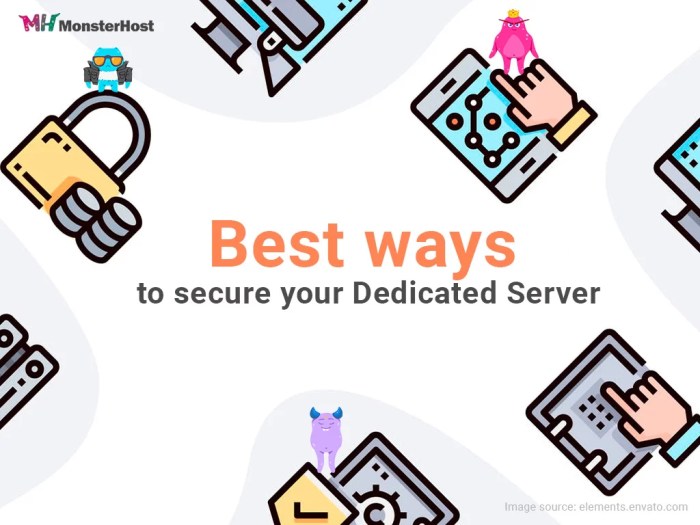
A comprehensive incident response plan is essential for dedicated servers, as it Artikels the steps to be taken in the event of a security breach. This plan helps minimize damage, restore operations, and prevent future incidents.
Key Steps in Incident Response
A well-defined incident response plan should encompass the following key steps:
- Detection: Early detection is crucial for minimizing damage. This involves implementing monitoring tools and setting up alerts to identify suspicious activity. It is also important to establish clear procedures for reporting potential incidents.
- Containment: Once an incident is detected, the next step is to contain the damage. This may involve isolating the affected system, blocking network connections, or disabling compromised accounts. The goal is to prevent the incident from spreading to other systems.
- Eradication: The eradication phase involves removing the root cause of the incident. This may include deleting malicious software, patching vulnerabilities, or restoring affected systems to a clean state. It is important to thoroughly investigate the incident to understand how it occurred and prevent future attacks.
- Recovery: The final step is to restore systems and data to their pre-incident state. This may involve restoring backups, reinstalling software, and reconfiguring systems. It is important to document the recovery process to ensure that it can be replicated in future incidents.
Best Practices for Handling Security Incidents
Effective incident response requires a proactive approach and a well-defined plan. The following best practices can help organizations handle security incidents effectively:
- Regularly test the incident response plan: Conducting regular simulations allows organizations to identify weaknesses and improve their response capabilities. This ensures that the plan is up-to-date and relevant to current threats.
- Establish clear communication channels: Having a clear communication plan ensures that all relevant stakeholders are informed of the incident and its impact. This includes internal teams, external partners, and affected customers.
- Maintain detailed incident logs: Accurate documentation of all incidents is essential for analysis, improvement, and legal purposes. It allows organizations to track trends, identify patterns, and learn from past experiences.
- Develop a strong security culture: Encouraging a security-conscious culture within the organization is crucial for preventing and responding to incidents. This involves training employees on security best practices and promoting awareness of potential threats.
Security Tools and Resources
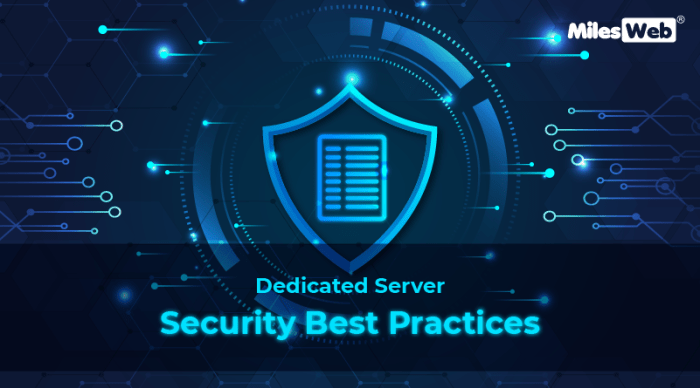
Leveraging specialized security tools and resources is crucial for maintaining a robust security posture for your dedicated server. These tools provide valuable insights, automate security tasks, and enhance your ability to identify and mitigate potential threats. This section explores various security tools and resources categorized by their functionalities and use cases.
Security Tools and Resources
The following table Artikels a selection of popular security tools and resources, categorized by their functionalities and use cases. Each tool plays a distinct role in bolstering your dedicated server’s security.
| Tool/Resource | Description | Features | Use Cases |
|---|---|---|---|
| Nessus | Nessus is a comprehensive vulnerability scanner that identifies security weaknesses in systems and applications. |
|
|
| Splunk | Splunk is a powerful security information and event management (SIEM) platform that aggregates and analyzes security data from various sources. |
|
|
| CrowdStrike Falcon | CrowdStrike Falcon is an endpoint detection and response (EDR) solution that protects against malware and other threats. |
|
|
| OpenVAS | OpenVAS is an open-source vulnerability scanner that provides comprehensive security assessments. |
|
|
Last Recap
Securing a dedicated server requires a multifaceted approach, encompassing a range of security measures, tools, and best practices. By implementing the steps Artikeld in this guide, you can significantly reduce your risk of cyberattacks and safeguard your valuable data and applications.
Remember, security is an ongoing process, and continuous monitoring, regular updates, and proactive incident response are crucial for maintaining a secure and reliable dedicated server environment.
